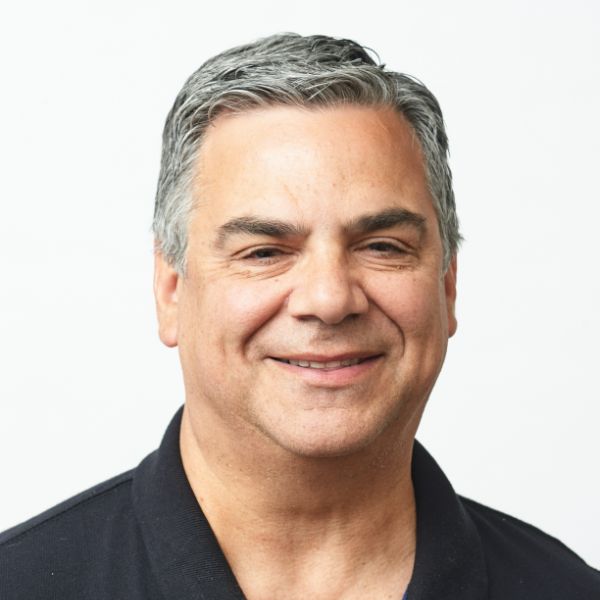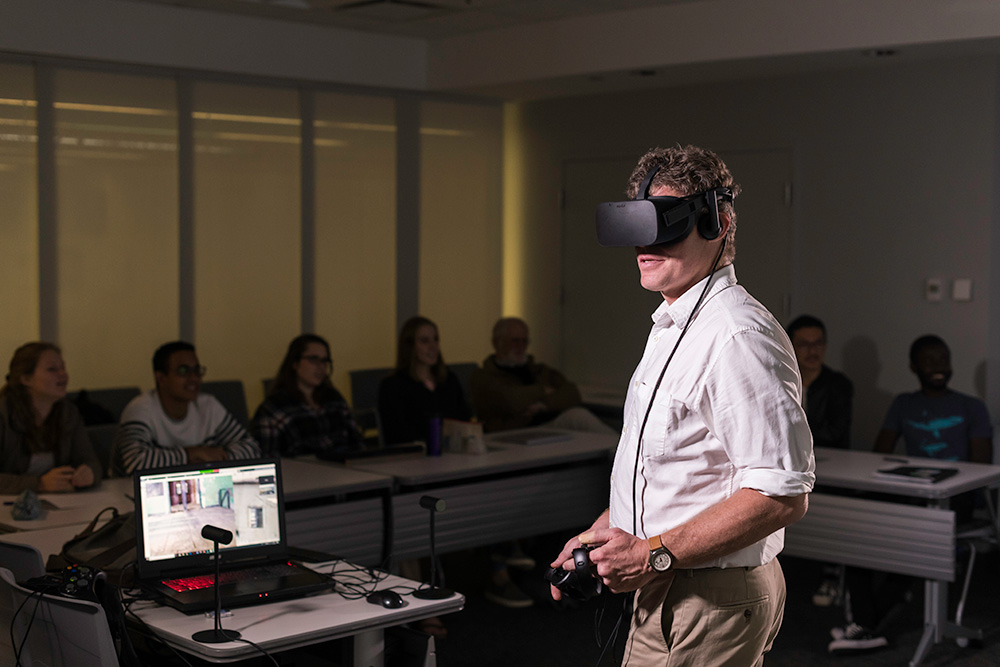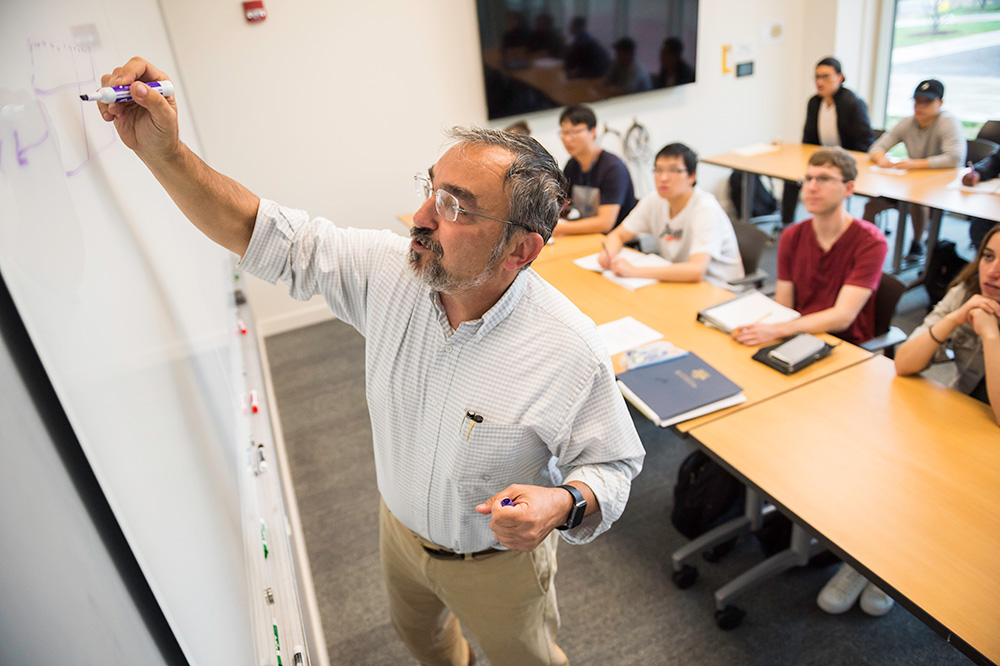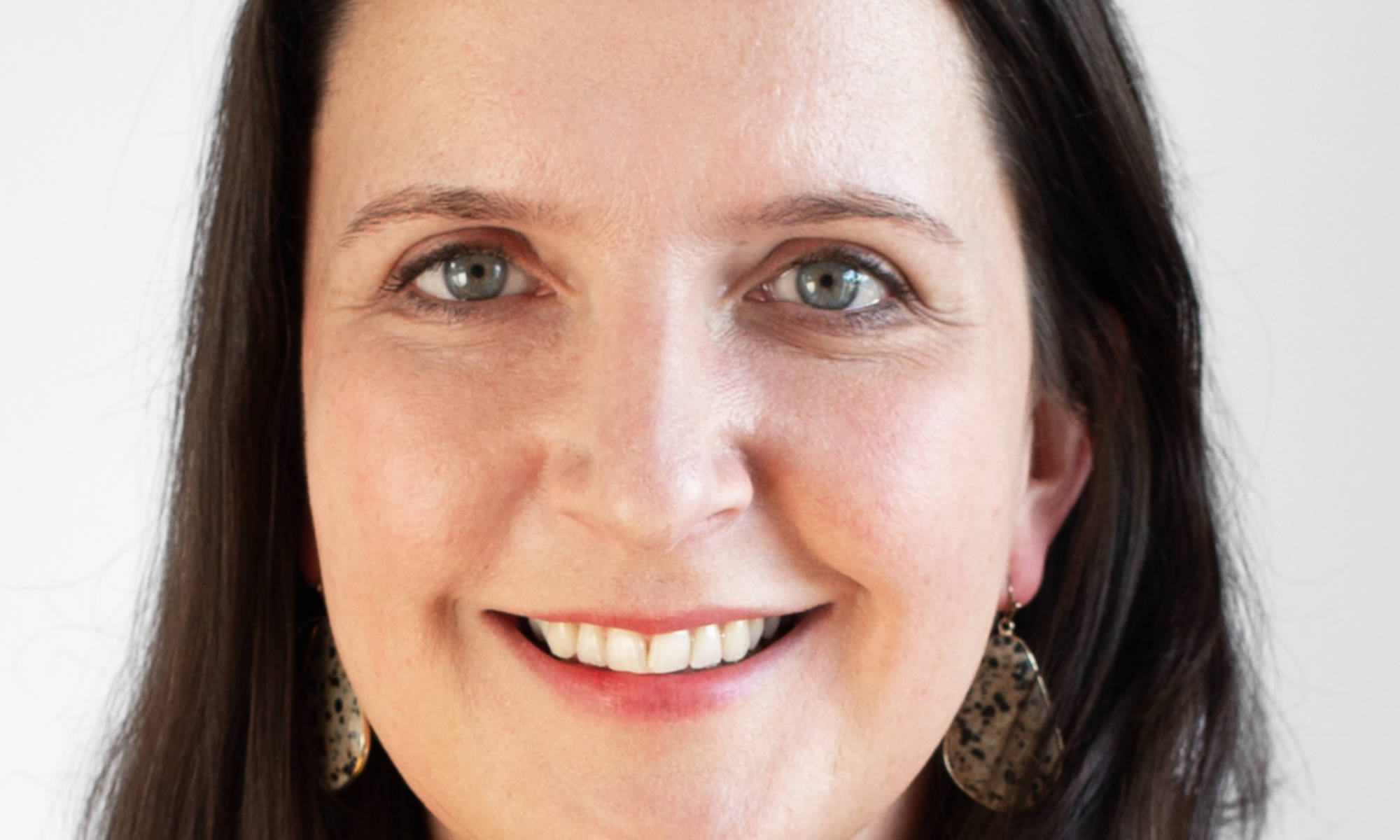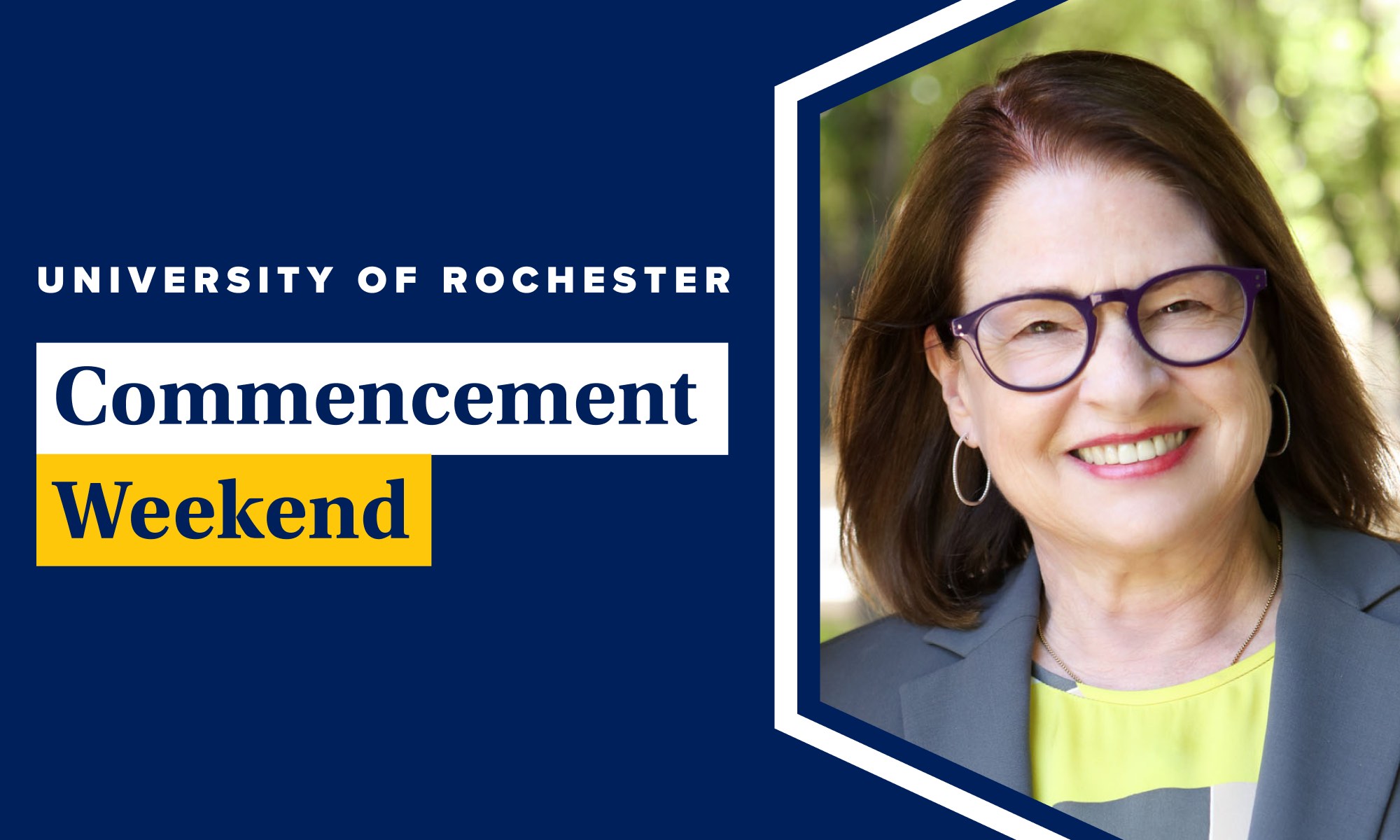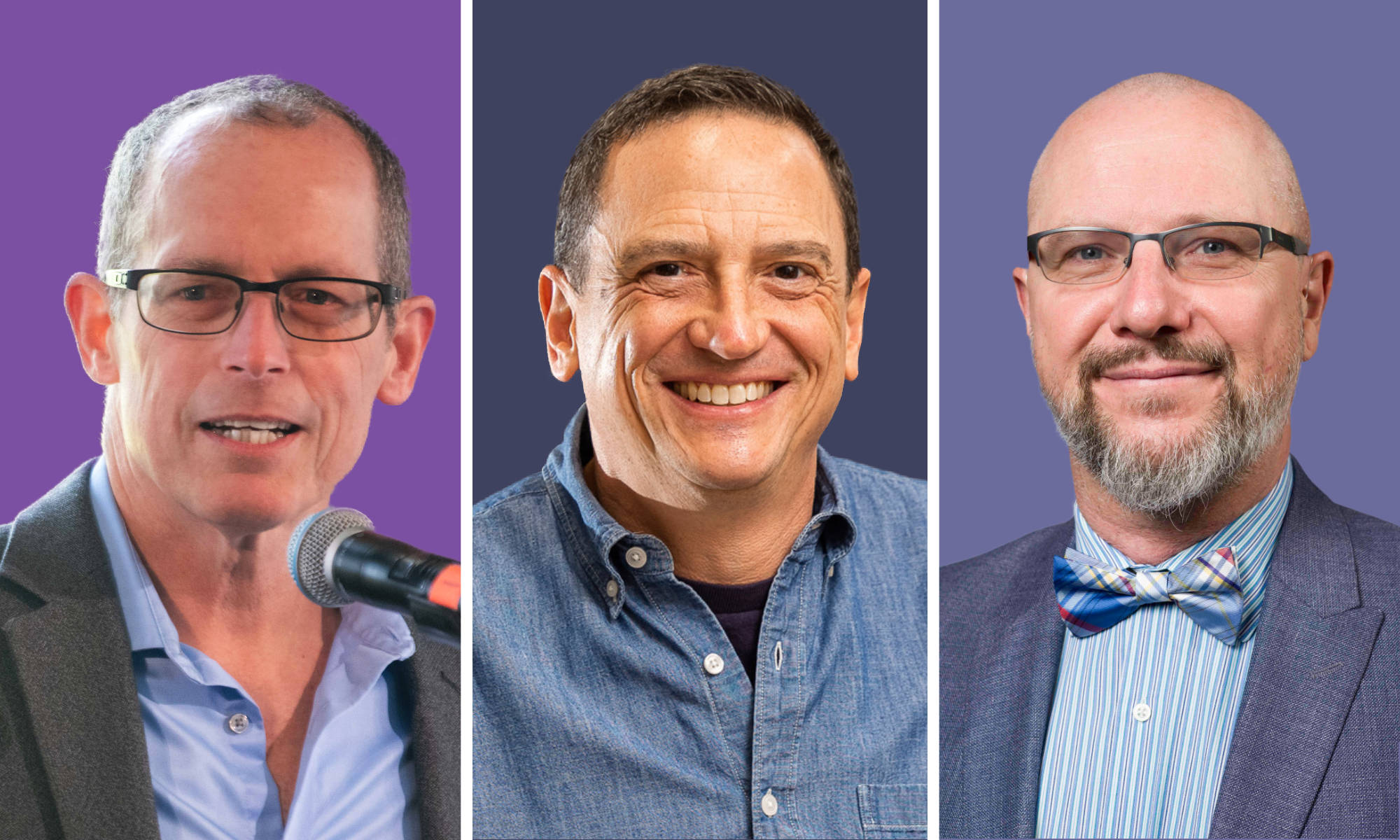Three professors will receive the 2018 Goergen Award for Excellence in Undergraduate Teaching at a 4 p.m. ceremony on Thursday, October 18, in the Hawkins-Carlson Room at Rush Rhees Library.
The award was established in 1997 by University trustee and Board Chair Emeritus Robert Goergen ’60 and his wife, Pamela, and recognizes distinctive teaching accomplishments of faculty in Arts, Sciences & Engineering. The award aims to acknowledge the full scope of work that contributes to excellence in undergraduate education.
This year’s recipients are Hayley Clatterbuck, an assistant professor in the Department of Philosophy; Michael Jarvis, an associate professor in the Department of History; and John Lambropoulos, chair of the Department of Mechanical Engineering.
Nominations come from students, faculty, staff members, and administrators. The winners are chosen by Jeffrey Runner, dean of the College; Gloria Culver, dean of the School of Arts & Sciences; and Wendi Heinzelman, dean of the Hajim School of Engineering & Applied Sciences.
“Great teachers do much more than simply transmit information,” Runner says. “They inspire their students to learn more, to ask questions, to push themselves beyond what they thought were their limits. I thank Bob and Pamela Goergen for enabling us to publicly recognize three such great teachers with this year’s Goergen Award for Excellence in Undergraduate Teaching.”
(University of Rochester photos / J. Adam Fenster)
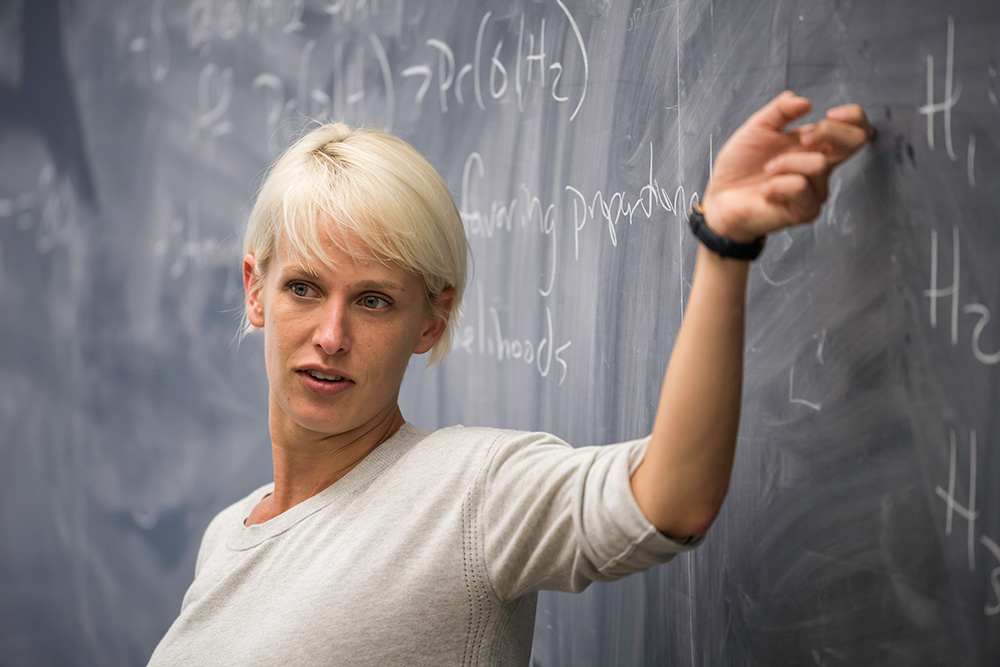
Hayley Clatterbuck
Hometown: Omaha, Nebraska
Joined University: 2015
Since 2015: Assistant professor in the Department of Philosophy
Degrees: BA, University of Nebraska–Lincoln (2008); PhD, University of Wisconsin–Madison (2015)
Personal: Lives in the Highland Park area and enjoys gardening, running, cycling, yoga, and snowshoeing. “I love winter,” she says. “And the colder, the better.”
What do students say? “In addition to making students feel empowered and comfortable to speak, Dr. Clatterbuck offered detailed feedback to make students better thinkers. In each of the classes I took with her, she assigned two papers per semester and wrote almost as much in feedback as we wrote in the papers.” —Sarah Hofmann ’17
My earliest dealings with philosophy came when I was a child. I was an overactive kid who had trouble sleeping. My dad started giving me thought experiments to help me fall asleep. He’d say, ‘Think about what life would be like if we had tails?’ Or, ‘if Thomas Jefferson visited you tomorrow, what would you show him?’ I’d spend all day with my next-door neighbor—he’s an engineer at Boeing now—playing with Legos and creating a whole fantasy world together. Those things helped me to become philosophical and were central to my development.
I used to think I would become a lawyer. My first idol was [retired Supreme Court justice] Sandra Day O’Connor, and I read many biographies of her. But my feelings changed after I received my bachelor’s degree. I took a year off from school to figure out what I wanted to do and worked at a law firm in Portland, Oregon. A lot of lawyers there were really unhappy compared to the professors I’d had in college, who had such lively existences. I began to change my mind. I took a lot of biology, psychology, and anthropology classes in college, but philosophy was my first love. Philosophy was the discipline that allowed me to learn about everything.
Early on, my teaching philosophy was ‘me’ centered. What do I want my students to know, and how do I want to communicate that? But it’s evolved to make it student-centered, to put them in the middle and see how they’re viewing the material from their eyes. Sometimes when class isn’t going great or you can tell students aren’t getting what you’re trying to communicate, there’s an instinct to turn inward or go back to your lecture notes and not look at your students. But you have to fight that instinct and make those moments of engagement. Why aren’t they getting it? What can I do better? It’s the thing I’ve had to work hardest on. Now, my classes tend to be free-wheeling and student-led.
There’s one technique I like to use: before we investigate a new topic, I like to present a proposition to the class and ask students to vote on whether they think it is true or false. In my philosophy of science class, I asked students whether they leaned toward “true” or “false” for the statement, “There is a scientific method – embodied in the methods scientists use to evaluate hypotheses in light of data – that is objective and reliable.” I’ve found that once a student commits to a position, even tentatively, they are much more likely to defend it. This method also tends to get students thinking about what the statement really means and how we would evaluate its truth. It gets students started doing philosophical analysis instead of waiting for me to tell them what I think, and it brings to light the presuppositions that students bring to course topics.
I don’t see philosophy as a subject matter as much as a methodology applicable to all other subject matters. In philosophy courses, we tend to focus on subjects that haven’t yet been turned into applicable sciences. But fewer than 10 percent of my students are philosophy majors. Most are scientists. My goal is always to find what my students are interested in and make them better at that by giving them the tools I think philosophy gives, teaching them a methodology I think is distinctive to our study rather than putting the material first and foremost.
By the time my students leave my class, I hope they will take whatever they’re passionate about and use philosophy to make them better at it. I’m interested in teaching them to think about what should count as evidence for other statements, and to always question themselves or be more rigorous and open minded at the same time. And I hope to promote a spirit of democratic debate in classes and teach them to understand how to productively disagree with someone and get to the truth together.
I’ve only been here three years, so the Goergen Award came as a nice surprise. It means a lot to me. I care very deeply about teaching. It’s the thing I’m most proud of. I love that people work very hard here, because hard work gets appreciated and noticed and makes for a great environment.
Michael Jarvis
Hometown: Stroudsburg, Pennsylvania
Joined University: 2001
Since 2009: Associate professor of history
Since 2014: Director, Digital Media Studies program
Degrees: BA, Rutgers (1990); PhD, College of William & Mary
Personal: Lives in Penfield, a suburb of Rochester, with wife, Anna; daughters Charlotte, 20, and Katie, 15; Plays volleyball, and enjoys video games and reading.
What do students say? “Professor Jarvis cultivates an open and effective environment, both through his curriculum and teaching style. Students always feel comfortable approaching him outside the classroom. His attention to each student is rare, and is guidance is unparalleled.” —Michelle Bushoy ‘19
I grew up in the Pocono Mountains in northeastern Pennsylvania, surrounded by ski slopes and the Appalachian Trail. Where I lived shaped the direction I took in life. I was very active. I was in Boy Scouts and into hiking, canoeing, and whitewater rafting. In the woods behind my house, there were depressions where old farmhouses and barns had once been, and you could see in the woods the stone fences from farmers 200 years ago. As a kid, I was curious about the lost buildings, and that sparked an interest in archaeology. Both of my parents influenced my career. My dad was a history professor who taught a few summer sessions in England and Austria, so I was exposed to living in a medieval town. My mom ran a school computer lab, which took me on the Oregon Trail and other historic places without ever leaving home.
After I wrote my dissertation on Bermuda, I applied for 40 jobs and got none of them. But one of the guys in charge of a job search had been an instructor of a semester-at-sea program. He suggested my name, and I got a job I never applied for, spending a year teaching maritime history on a wooden schooner. I never had a better classroom. The semester-at-sea started in Boston and ended in Haiti. The schooner was 70 feet long and 20 feet wide, and included 25 students, six crew, and two teachers. I was half of the faculty. The kids ran the ship, and we had an 19th century sense of the world. We only moved as fast as the wind took us, no more than 6 miles per hour. It was very crowded, and everyone knew everyone’s business. When a couple broke up, we all had to share in that in the weeks ahead.
An idea came to me around 2012: what if we harnessed this computer technology that’s creating fantasy worlds in video games to create actual worlds. That was the start of the Virtual St. George’s Project, an immersive historical simulation of life in Bermuda’s 17th- and 18th-century capital town. When I started digging my archeological sites in Bermuda, I’d spend a month clearing tons of dirt to get down to a foundation, record it carefully with photographs and maps, then have to fill it in. Eleven months would go by until we came back. And this is a remote island that you get to by boat. Even some Bermudians can’t get to the site. I wondered, what if you could take that site with you for the other 11 months and show people how the archaeology is done, through the virtual means of a computer? I blogged and recorded in real time every couple of days, and I created digital models to let people see the sites.
Once you can record an archaeological site, you can record a whole town or a whole castle. The next step is taking people to that site 200 years ago. You’re shifting from what’s there today, captured from reality, to historicizing these places by using computer programs to build houses that are no longer there. We can see from sketches what the town looked like 200 years ago and use evidence like roofs and windows, deeds and maps for lost houses. And we recreate it. I built a digital history class around that. There are about 120 properties on St. George’s. Every student gets one of those houses and takes it from when the deed was granted 300 years ago through historical research using deeds, wills, and newspapers. Then they use 3-D software and photos to build a 3-D model of the house.
I became involved in the Elmina Castle project in Ghana in 2016, the first step in a multi-year project of recording, analyzing, and comparing all of Ghana’s 30-plus surviving trading forts. I was blown away by what I saw. Elmina Castle was built by the Portuguese in 1482 and is the oldest and largest slave fort in Ghana. It’s wonderfully preserved and an ideal site for students to study how a sprawling 500-foot-long, 160-room castle has evolved over 500 years.
My philosophy has always been, you learn by doing—by putting yourself in the shoes of an historical subject. When I was in college, I was a blacksmith at an historic village. I learned about the physicality of work, what goes into making a hinge, nail, gun or harpoon. When my students go to Ghana each summer, the first thing that hits them is the heat. It’s 80-something degrees with 90 percent humidity. And you’re right by the equator, so the sun rises at 6 a.m. and sets at 6 p.m. They have to adjust to all of the elements.
I don’t have a set teaching style. It varies depending on who I’m teaching and what level I’m teaching. Lecturing is an efficient way of teaching everything you didn’t know about history. But you also teach with artifacts, passing around Roman pottery from 2000 years ago and thinking about the people who used it. We watch films and then discuss them, how a reenactment can give you an insight that books can’t. We go to places. We’ll read scholarly works for their content and to show the tools and evidence a historian uses. History is argument, not script. You empathize with refugees by playing a video game that takes the gun away from you and makes you a witness to the people who get shot and who are the victims. I’m involved in history, archaeology and digital media studies. They seem like really different worlds, but the questions we ask and the things we try to build are pretty much the same for students at the end of the day.
John Lambropoulos
Hometown: Tsotyli, Greece
Joined University: 1984
Since 2007: Chair, Department of Mechanical Engineering
Degrees: BS, Brown University (1980); PhD, Harvard University (1986)
Personal: Lives in Pittsford; two of his three sons attended the University of Rochester: Teddy ’09, ’14 (MS) and Alexander ’15; enjoys reading and serving as a local amateur soccer referee.
What do students say? “Professor Lambropoulos displays an extreme mastery in not only what he teaches, but also in communicating what he teaches. His ability to explain complicated engineering concepts and theories make them seem as simple as high school algebra. His animated personality completely takes over the room and leaves me wishing to do nothing more than watch my professor teach a subject he has been teaching for years.”
—Onur Bagoren ’19
I grew up in a small village in northern Greece. My family didn’t own a TV until I was 15 and there was limited radio, so you received your news from the newspaper and by talking to people. It was a different world. But it was a very happy life. My dad was an army officer, and my mother and grandmother were school teachers. I had a younger brother and lots of cousins, and I spent a lot of time playing soccer with our neighbors. We enjoyed each other very much.
I attended high school at Athens College, a prep school in Athens. I learned English, but it was ‘academic’ English. I could read fluently and converse, but I never actually spoke English to a person until I came to America. A large number of my classmates ended up at prominent US institutions. I chose Brown and moved to America by myself as an 18-year-old in 1976, the Bicentennial year. At that time, we were called ‘foreign students,’ but I never felt like a foreigner and never felt discriminated against academically or socially. I had a host family help me open a checking account, buy bedsheets and textbooks. I think my parents were more worried than I was.
My original plan was to have a career in the field of chemistry, but things quickly changed at Brown. I liked chemistry in high school and started at Brown as a chemistry major. But I soon realized I didn’t like chemistry labs so much, so I changed to chemical engineering. Then, I realized you still had chemistry labs, so I decided to give mechanical engineering a shot. I had a great teacher my first class and really enjoyed it, so I decided to follow that track.
I’ve had a longstanding policy since I arrived here of never giving in-class examinations. All of my exams are in the evening. At the beginning of each semester, I tell the students to block out certain nights. I design the tests as one-hour exams, but I give everybody three hours to take them. The students don’t feel as stressed, and they have more than enough time. The most challenging part of teaching is to make sure nobody gets left behind.
My teaching style is an approach I learned as a soccer player and coach. Let me explain: In soccer, you split the practice in “thirds”: The first third is repetition of fundamental skills so as to develop the muscle (or brain) memory by extensive repetition. The second third is on small-sided drills to develop the context of applying the fundamental skills in a new setting. The last third is on full-sided practice where the fundamental skills and the new material are integrated in a full-scale situation. In my classes, I devote the first 15 minutes to repetition of the fundamental skills, the middle third to introducing new material, and the final third to a large, complex topic that integrates everything. Just like a coach knows the name of each player, I know the names of all my students.
I never use notes in teaching, essentially because I prefer to look at students constantly in a dialogue setting, rather than read and copy my notes. I like to ask a lot of questions to all the students all the time. Something I’ve enjoyed and students have responded to positively are design projects where students work in small groups. The projects last all semester. Students love them because they involve extensive communication, brain storming, research, and integration of all they have learned up this point, including math.
I’m a huge advocate of the study abroad program. It’s so important for students to see a different way of looking at the world through different cultures.
In many overseas universities, the education system is designed so that you go to class an entire semester, and your whole grade rests on a final exam. If you have a toothache or headache or slept poorly the night before an exam, too bad. It’s very different from our system in America. The world sees education differently, and it’s important for students to understand that. Students enrich themselves culturally and professionally by studying abroad. They’ve demonstrated they can function overseas, and companies like that.
It’s not often you can see the same university from the eyes of a faculty member and a parent. I did, and it was eye-opening. I attend Commencement every year, and I wear the gown and hood. But when Teddy graduated in 2009, I wore a suit and tie and sat among the parents (with Alexander, I awarded him his engineering degree). It was fascinating to see what a moving experience graduation was as a parent, and I think it helped me as a teacher.

